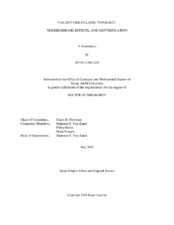| dc.description.abstract | Traditional views on urban vacancies have been concerned primarily with the negative influences on safety, property values, and health issues; more recent views attempt to shed light on the potential for greening and stabilizing vacant properties in an effort to better manage urban decline. The conventional negative views on vacant lots are not always true as they can also be thought of as opportunities for growing cities. Alternatively, certain types of vacant lands (e.g. green space and treated brownfields) can have the potential to encourage neighborhood gentrification.
This research examines these opposing views and attempts to answer if the repurposing of vacant land can be an opportunity for disadvantaged neighborhoods, or if certain types of vacant land tend to encourage gentrification. The research question directed by this inquiry is “What types of vacant land are positively associated with neighborhood gentrification?” To answer this question, this study examines 1) what are the land characteristics contributing to long-term vacancy, 2) how neighborhood socioeconomic characteristics are associated with vacant land types, and 3) what types of vacant land are associated with the gentrifying process of a neighborhood using Minneapolis, MN as a study area.
This research first examines if land characteristics can contribute to long-term vacancies using Kaplan-Meier survival estimates. Three common land characteristics – land use, parcel size, and ownership – were analyzed to identify different life-cycles of vacant land by land characteristics and to suggest a typological classification. The results indicate that small, publicly-owned, industrial and institutional lands tend to have long-term vacancies. Six vacant land types – Remnant, Speculative, Reserved, Dormant, Civic, and Recreational lands – were developed accordingly. This research also examines if neighborhood-scale socioeconomic characteristics can predict the vacancy types identified above. A logistic regression model was specified for each vacant land type. The results indicate a few points. First, vacant residential and commercial vacancies tend to be located in areas with a high minority population. Second, institutional vacant properties are located in low-income areas with a low minority population indicating potential inequality issues. Third, neighborhood scales predict the vacancy types better than the site-scale socioeconomic status indicating that neighborhood contexts can be more influential than the actual site conditions. This research lastly examines the relationship between vacancy types and neighborhood gentrification at the census block group level using spatial analysis. Speculative and Reserved lands are positively associated with neighborhood gentrification supporting the hypothesis; Civic land showed a negative association; Remnant, Dormant, and Recreational lands showed no significant relationship with gentrification.
This dissertation extends vacant land research into the potential issues of social equality incurred by the existence of prevailing types of vacant properties. When local governments choose to demolish or green an abandoned property, the potential impact on existing and remaining neighborhood populations needs to be taken into deeper consideration. This study also further introduces the tools to measure and categorize citywide vacancies. This diagnostic tool helps predict either neighborhoods’ positive gains from redeveloping vacant land into green spaces and spaces for community functions, or the potential risks of nearby gentrification by regenerating vacant land. | en |


